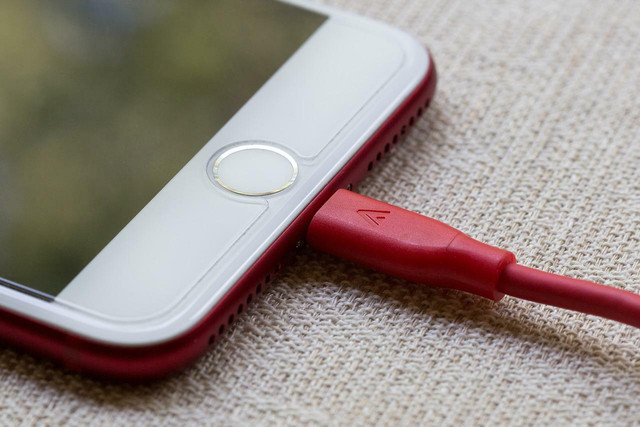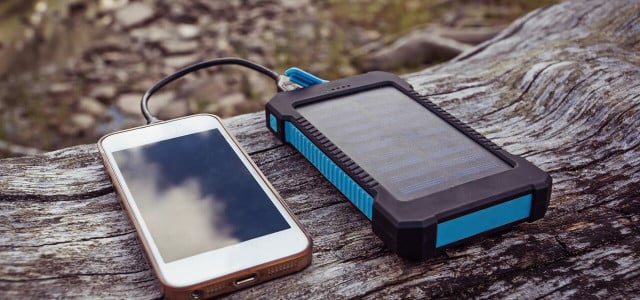We’ve rounded up a list of the eight best solar power banks available to purchase in 2022. These are perfect if you want a sustainable charging option on the go.
How many times have you found yourself stuck with a dead phone and no way to charge it until you can reach an electricity source? If you’re a lover of the great outdoors, this issue can often occur on long journeys.
However, there’s a solution. If you’re looking for an easy and sustainable way to charge your device, then solar power banks are definitely for you. Not only do they help you reduce your carbon footprint, but they’re also portable. This means no matter where you go, you’ll be able to use your solar power bank (weather permitting, of course).
So, if you’re looking to cut down on your carbon footprint or purchase a more sustainable charger, we’ve got you covered. Below, we’ll break down the pros and cons about some of the best solar power banks out there.
What Are Solar Power Banks?

(Foto: CC0 / Pixabay / mhoppsy)
A solar power bank is an energy storage device that harvests energy from the sun, rather than relying on electricity. The device will then use the harvested energy to charge your phone, or any other devices you may have.
By using the sun to charge itself rather than electricity from an external power source, a solar power bank acts as an eco-friendly and sustainable option for those who want a ‘green’ charging option on the go.
How Do Solar Power Banks Work?
A solar power bank works by harvesting energy from the sun, which is then converted into electricity and used to charge the rechargeable battery that sits inside the device. This is particularly useful as you actually don’t have to plug the device into a plug socket – you can charge it anywhere.
To harvest energy in this way, a solar power bank will use the solar panels that are built into its design. This can either be a small solar panel built on top of the device, or several can be used to create a ‘belt-like’ structure. The battery sits inside the device.
When exposed to sunlight, the solar panels will then absorb energy from the sunlight using the PV cells inside each panel. This energy creates electrical charges and thus, allows electricity to flow.
When choosing a solar power bank, it is important to ensure that the output of the portable charger is equal to your phone’s input battery voltage requirement. You should also check this for any other device you are looking to use the portable charger with. The best solar power bank for you should fit your device’s needs.
Advantages of Solar Power Banks
Solar power banks come with a wide variety of benefits:
- Sustainable: Solar power banks are sustainable and eco-friendly, posing minimal harm to the environment. Most of the materials that make up a solar panel can be recycled, including the aluminum frame, solar glass, the cells made from silicon and metals as well as the junction box.
- Decreased carbon footprint: They can help lower your carbon footprint, as you’re reducing the amount of electricity you consume from the power grid. Consequently, this reduces the amount of greenhouse gases that you would otherwise produce from using electricity.
- High power capacity: The best solar power banks can hold a high level of power. This is useful if you ever find yourself having to charge your device using external electricity because you won’t have to do it often. Generally speaking, this high capacity also means the battery power should last a long time.
There are also other benefits to the solar power banks, including:
- Nighttime charging: The device allows you to charge your phone at night, even when there is no sunlight (as long as the device is charged).
- Portability: Solar power banks are portable, meaning you can take them everywhere and have a source of electricity. With a normal portable phone charger, you’d have to wait to gain access to an electricity port.
Besides using solar power banks, there are also other ways you can save on electricity, such as unplugging your devices from the source when not in use, and switching to LEDs.
Disadvantages of Solar Power Banks
There are also some important environmental disadvantages to bear in mind when considering a purchase of a solar power bank. These disadvantages can include:
- Toxic chemicals: Solar panels can contain toxic chemicals such as lead and cadmium, both of which are harmful to the environment. Each standard solar panel contains roughly 14 grams of lead, mainly from the soldering process for the electronic components. However, standard solar panels are much larger than the ones used for solar power banks, so the amount of lead is likely to be a lot lower in your charger. In addition, there is some good news. By 2026, solar manufacturers plan to reduce the use of lead so that less than 50 percent of solar panels will contain the material. In addition, manufacturers are hoping to shrink this figure year on year until the lead is completely removed from the solar supply chain. Cadmium is also found in the thin solar film on the panels. However, very little of it escapes into the environment and its market share is expected to shrink to less than 2 percent in the future.
- Production process: Greenhouse gas emissions can be released during the solar panel production process.
- Weather dependent: The devices aren’t 100 percent reliable — your use of the device will be very weather-dependent. If it’s not sunny, you’ll risk not being able to charge your devices.
- Recycling issues: Currently, there are not enough locations to recycle old and used solar panels. This means that precious materials needed to create the devices could be going to waste.
Despite having disadvantages, solar power bank chargers still have a substantial environmental advantage when compared to regular power bank chargers. According to Cool Effect, a non-profit crowdfunding platform that seeks to reduce carbon emissions, solar panels have a lower carbon footprint when compared to coal-powered electricity. In addition, you will have a potentially endless supply of power.
If you’re looking to bring this solar magic closer to home, you also have the option of purchasing outdoor solar lights. These lights function in the same way as a solar power bank would — by using the sun to harvest energy.
How to Choose the Best Solar Power Bank for You in 2022
When choosing a solar power bank for yourself, there are several factors that you should consider, including:
- Power capacity: Choosing the right power capacity is important as you will need a battery big enough to charge your desired device. If you want to use the power bank for multiple devices, then opting for a higher power capacity is a better option. If you’re using it for just your phone, a smaller capacity would be perfectly suitable.
- Price: The price of your solar power bank is obviously a very important factor. Try to find a device that has good durability and capabilities for a fair price. However, if you have a higher budget, you can be more flexible with your choice.
- Weight: Something small and light will be easy to carry around and is better suited for those who are just looking to charge their portable electronic devices. However, if you need something reliable, you may have to opt for a heavier device.
- Compatibility: Above everything, it is important to ensure that the charger is compatible with your desired device. Make sure to check that the output of your portable charger is equal to your phone’s input battery voltage requirement.
1. The Best Versatile Option: BLAVOR Solar Charger Five Panels Detachable
Pros:
- It’s versatile. Each of the solar panels is detachable.
- Capable of wireless charging, meaning you can charge your phone with ease. However, check first if your device supports Qi wireless charging technology.
- It has a 20000 mAh capacity, providing you with charging power for days. For example, the BLAVOR solar charger can provide between 4 to 5 full charges for the IPhone X and above — and almost 5 full charges for Samsung Galaxy S10.
- It has a flashlight mode and features two USB ports.
Cons:
- The panels aren’t waterproof.
Price: $78.95 purchased from Walmart.
This is one of the best versatile solar power banks you can buy.
2. Best Overall Solar Power Bank: Qisa Solar Power Bank
Pros:
- Waterproof.
- Long-lasting. Very large 38,800 mAh battery.
- Wireless charging.
- Can charge multiple devices at once.
- Has a bright flashlight.
- SOS Mode.
Cons:
- Large and heavy.
Price: $37 on Amazon**.
3. Best Solar Power Bank for Mobile Devices: FEELLE Solar Power Bank Charger
Pros:
- 25,000 mAh high-capacity battery.
- Fold-out panels.
- Dual USB ports.
- Water-resistant.
Price: $44 on Amazon**.
4. The Best Option for Navigation: BLAVOR Solar Charger Power Bank
Pros:
- Fast wireless charging.
- 20000 mAh battery capacity.
- Can charge an IPhone X 4.5 times.
- Waterproof.
- Dual inputs.
- Built-in compass.
Price: $49.99 on Amazon**.
5. Best for Camping Lovers: BigBlue 3 Solar Power Bank Charger
Pros:
- Compatible with iPhone 11/XS/XS Max/XR/X/8/7, iPad, Samsung Galaxy LG and more.
- Waterproof.
- Highly durable solar panels.
- Compact and lightweight, weighing only 20.5 oz.
- Auto-restart function.
Cons:
- You need to connect your device to the solar charger under direct sunlight outdoors to be able to charge your device.
- This solar charge can’t support laptop devices.
Price: $69.96 on Amazon**.
6. The Best Compact Option: Ryno Tuff Solar Power Bank Charger
Pros:
- For every purchase of a Ryno Tuff Solar Charger, a tree will be planted through the National Forest Foundation.
- Foldable and compact.
- Charging algorithm that distributes power in the most efficient way.
- Automatically stops charging when fully charged or when the device is overheated.
- Lightweight option.
- Waterproof.
Cons:
- Only charges when exposed to direct sunlight. There is no internal battery that stores the power.
Price: $56.99 on Amazon**.
7. The Best Lightweight Option: Anker PowerPort Solar Power Bank
Pros:
- Lightweight.
- Foldable
- 21w charger.
- Efficient charging.
- Multi-device charging.
- Durable and able to withstand harsh conditions.
- Small and sleek.
Cons:
- Pocket too small to hold extra cords and other accessories.
Price: $69.99 on Amazon**.
8. Best Multi-Purpose Solar Power Bank: Raddy SW5 Emergency Radio
Pros:
- Has a weather radio with an IPX5 waterproof case.
- Has an SOS alarm, compass, reading lamp, and flashlight.
- Can save space when camping due to multi-functionality.
- Choice of three charging modes.
Price: $39 on Amazon**.
Things to Watch Out for
When choosing the best solar power bank for you, there are some important things to keep in mind in order to make the most out of your purchase.
At the end of your solar power bank’s life cycle, it is important to dispose of it properly, as some of the materials may be harmful to the environment.
The best option is a solar recycling company, which you can find using websites like SolarRecycle.org. The website shows vendors in each state where they are available, so you can check to see if there are any located near you.
Read more:
- Are Solar Panels Recyclable? What You Should Know
- 20 Great Camping Tips to Maximize Your Fun
- How to Recycle Light Bulbs – and Why It’s Important
Do you like this post?








